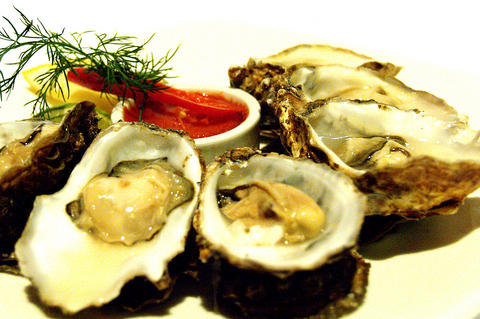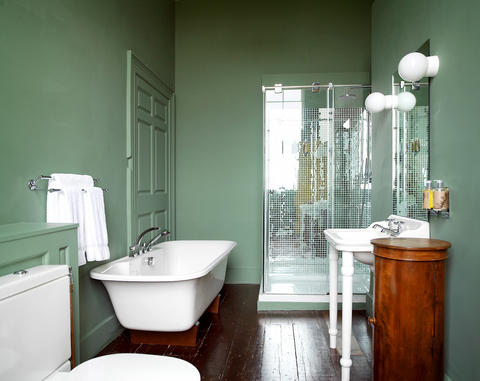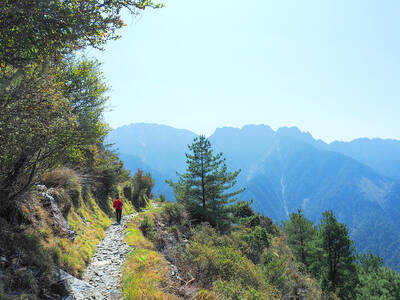The drawing room of Bellinter House has many classic Georgian features. There are wide, dark-stained timber floorboards, soaring floor-to-ceiling sash windows with paneled shutters, and deep cornices supporting a ceiling of elaborate ornamental plasterwork. But look at the furnishings of this fine 1750 Palladian-style hotel, 50km north of Dublin, and you could be forgiven for thinking that you've wandered into a funky urban bachelor pad. There are glass-and-chrome coffee tables, 1950s leather armchairs, and two paper-and-wire wall lights playfully shaped into antelope and bison trophy heads.
This mingling of traditional rural mansion and eclectic contemporary styling is well established in Britain, at such "groovy grand" hotels as Cowley Manor in the Cotswolds, The Grove in Hertfordshire and Babington House in Somerset, but Bellinter is a departure for the Irish hotel market.
Pitched somewhere between the boutique bling of designer hangouts such as Dublin's Morrison and Galway's G Hotel, and the more genteel surroundings of country houses like Ballymaloe House in County Cork and Castle Leslie in County Monaghan, Bellinter has attracted much attention since it opened last December.

PHOTOS: COURTESY OF BELLINTER HOUSE
This is partly because the hotel is co-owned by one of the country's most successful businessmen, Jay Bourke. With partners Eoin Foyle and John Reynolds, Bourke has opened a dozen or more clubs, bars and restaurants, mostly in Dublin, over the past 15 years, from the POD and Ri-Ra nightclubs to the budget Cafe Bar Deli restaurant chain and the Odessa private members' club. "When we were in our 20s, we opened nightclubs; when we were in our 30s, we opened restaurants; and now we're in our 40s it seems only right to open a hotel," says Bourke, 41.
Bellinter is for fashionable city folk caught socially somewhere between the night club and the golf club; a country house hotel for the acid house generation. The three-year, £1 million renovation and redevelopment of the house was overseen by one of Ireland's hippest architects and designers, Pierce Tynan, who has created a feel of what he calls "threadbare elegance." While the preserved buildings - a main house with projecting wings and connecting colonnades designed by the renowned architect Richard Castle, who created the Irish parliament building, Leinster House - have been meticulously restored, there is no excessive purity about the hotel.
One of the reception rooms is now a games room, complete with wall-mounted flat-screen television and blue-baized American pool table, and in the library there is an old oxblood leather Chesterfield armchair that has a front leg propped up by two blocks of wood. The guiding hand here is humorous, honest, slightly leftfield.

It's an approach that extends to the 34 bedrooms, some of which are in former outbuildings. All have hi-tech features such as multimedia, 40-inch LCD televisions, Bose sound systems, wireless Internet access, and remote-control lighting. There are luxuries such as extra-large beds, Frette bed linen and goose feather pillows.
The country-urban feel is completed with bespoke Japanese-style wardrobes handmade in Irish ash, and cowhide rugs sourced from a local tannery. There is the obligatory spa, but again with interesting twists; a range of modern treatments are available in the seven treatment rooms, but there are also traditional seaweed baths. Elsewhere, there is an indoor swimming pool with a sauna and steam room, an outdoor hot tub, and a heated infinity pool with fine views over the river Boyne.
Brown trout fishing is also available; Bellinter has rights to a 4.8km stretch of river. One of Europe's most important and fascinating Neolithic monuments, the passage graves at Newgrange, older than the Pyramids, is around half an hour away by car. Bellinter is very much a work in progress, with more facilities opening over the coming months. Past the two giant, 250-year-old beech trees on the front lawn, two more outbuildings are being converted into a cinema and children's playhouse; the latter will have a miniature version of the nearby Hill of Tara, the mythical seat of the high kings of Celtic Ireland. Diarmuid Gavin's "pavilion pod," a silver medal winner at last year's Chelsea Flower Show, will also have a permanent home in the gardens by the end of the year.

Unfortunately, the unfinished nature of the project seems occasionally to extend to the service. The staff is young, friendly and very willing to help, but sometimes their inexperience shows. If you're paying up to £260 (NT$17,200) for a room, you don't expect the hotel barman to greet you with "yes, mate." You are not in a Dublin boozer; you are in a wonderful mahogany and marble bar, the traditional vibe of which has been subverted by a specially commissioned mural by leading Irish artist David Godbold of an angel looking down on a fairy-tale mountain landscape.
The vaulted cellar restaurant, sister to Bourke's Eden brasserie in Dublin, can feel a bit austere on sunny mornings and early evenings, although breakfasts and lunches are served on the back lawn, weather permitting. The sound of the space needs more care, too; the Gotan Project's La Revancha del Tango CD, in itself a ubiquitous cliche, was played on a loop for all four meals we had in the restaurant. Still, these are small quibbles in a new hotel that gets many more things right than wrong. Not only have Bourke and his team thoughtfully and intelligently restored a landmark Irish property, they have also captured a sense of a long history of hospitality. Bellinter seems somehow to embody the Irish gift for mixing people up and making them feel comfortable.
As Bourke says: "Bellinter is a very happy, very egalitarian, and very Irish country house."

On the Net: www.bellinterhouse.com.

“Why does Taiwan identity decline?”a group of researchers lead by University of Nevada political scientist Austin Wang (王宏恩) asked in a recent paper. After all, it is not difficult to explain the rise in Taiwanese identity after the early 1990s. But no model predicted its decline during the 2016-2018 period, they say. After testing various alternative explanations, Wang et al argue that the fall-off in Taiwanese identity during that period is related to voter hedging based on the performance of the Democratic Progressive Party (DPP). Since the DPP is perceived as the guardian of Taiwan identity, when it performs well,

The Taiwan People’s Party (TPP) on May 18 held a rally in Taichung to mark the anniversary of President William Lai’s (賴清德) inauguration on May 20. The title of the rally could be loosely translated to “May 18 recall fraudulent goods” (518退貨ㄌㄨㄚˋ!). Unlike in English, where the terms are the same, “recall” (退貨) in this context refers to product recalls due to damaged, defective or fraudulent merchandise, not the political recalls (罷免) currently dominating the headlines. I attended the rally to determine if the impression was correct that the TPP under party Chairman Huang Kuo-Chang (黃國昌) had little of a

At Computex 2025, Nvidia CEO Jensen Huang (黃仁勳) urged the government to subsidize AI. “All schools in Taiwan must integrate AI into their curricula,” he declared. A few months earlier, he said, “If I were a student today, I’d immediately start using tools like ChatGPT, Gemini Pro and Grok to learn, write and accelerate my thinking.” Huang sees the AI-bullet train leaving the station. And as one of its drivers, he’s worried about youth not getting on board — bad for their careers, and bad for his workforce. As a semiconductor supply-chain powerhouse and AI hub wannabe, Taiwan is seeing

Jade Mountain (玉山) — Taiwan’s highest peak — is the ultimate goal for those attempting a through-hike of the Mountains to Sea National Greenway (山海圳國家綠道), and that’s precisely where we’re headed in this final installment of a quartet of articles covering the Greenway. Picking up the trail at the Tsou tribal villages of Dabang and Tefuye, it’s worth stocking up on provisions before setting off, since — aside from the scant offerings available on the mountain’s Dongpu Lodge (東埔山莊) and Paiyun Lodge’s (排雲山莊) meal service — there’s nowhere to get food from here on out. TEFUYE HISTORIC TRAIL The journey recommences with